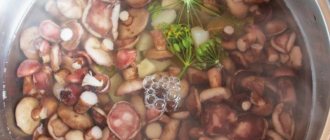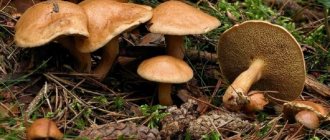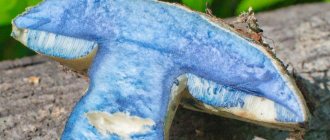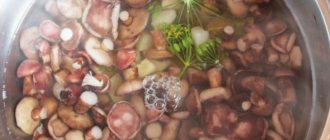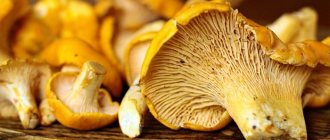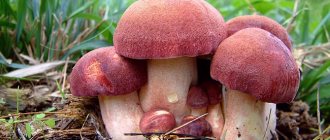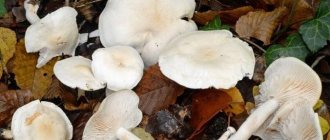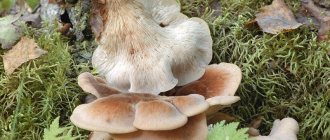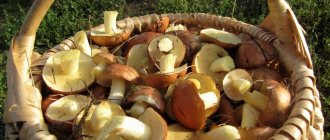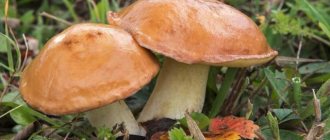Mushroom poisoning is a rather unpleasant phenomenon, in some cases deadly. That is why many, even experienced mushroom pickers, are suspicious of any non-standard phenomena associated with their collection. One of these phenomena is the bluing of the site of damage or fracture of the fruiting bodies. Quite often, mushrooms that look like boletus turn blue when cut. Next we will consider whether this is the norm and whether it poses a danger to the mushroom picker.
Why boletus and similar mushrooms turn blue when cut when peeling: reasons
Mushroom poisoning is a rather unpleasant phenomenon, in some cases deadly. That is why many, even experienced mushroom pickers, are suspicious of any non-standard phenomena associated with their collection. One of these phenomena is the bluing of the site of damage or fracture of the fruiting bodies. Quite often, mushrooms that look like boletus turn blue when cut. Next we will consider whether this is the norm and whether it poses a danger to the mushroom picker.
Do boletus turn blue when cut?
The question of whether oilcans can turn blue in places of damage worries many mushroom pickers. But, in general, a change in the color of the fruiting body when damaged is characteristic of almost all representatives of the mushroom kingdom, without exception. It’s just that in some species it is almost invisible, in others the color may be slightly different, and in others (in particular, representatives of the Boletaceae family) it can be especially pronounced.
Below is a photo illustrating this phenomenon:
Why do boletus turn blue when cut?
The reason for the change in color of the stem or cap when damaged (no matter whether it is a cut or the result of cleaning) is the oxidative chemical reaction of the juices of the fruiting body and the oxygen contained in the air. The cut breaks the tightness of the stem, and the juices react with atmospheric oxygen
This property is inherent in all mushrooms without exception.
The cut breaks the tightness of the stem, and the juices react with atmospheric oxygen. This property is inherent in all mushrooms without exception.
What types of oilseeds turn blue when cut?
There are several types of Maslenkov, the place of damage of which turns blue:
- Larch gray or bluish. Its distinctive feature is its almost flat cap. Its surface is light brown. The stem should turn blue after cutting, which is reflected in its name. Nevertheless, it is classified as edible (albeit category 3); it is often eaten salted.
- Yellow-brown. His hat is the same color. It is classified as inedible, although not poisonous.
- Peppery. It differs from ordinary representatives of Boletidae in the absence of a ring and a reddish hymenophore. Also conditionally edible, but non-poisonous. Due to its excessively pungent taste, it is rarely used as an additive similar in effect to spices.
What other mushroom that looks like an oil can turns blue when cut?
Not only mushrooms such as boletus turn blue when cut. There are several types that also have a similar property:
- An ordinary bruise. Belongs to the genus Giroporus of the Boletaceae family. It has a large cap with a diameter of more than 15 cm. The stem is white, the cap is beige.
- Moss fly yellow-brown. Conditionally edible, similar in appearance to the Maslenkovs. If the color change occurs almost immediately after the break, it is most likely a flywheel. A distinctive feature is that the cap is quite thick. In addition, when cooked, this species turns all its “neighbors” red.
- Dubovik. A large olive-brown representative of the boletus genus. Found mainly in oak groves.
- Polish mushroom. Also a representative of boletus. Quite large, has a large and fleshy hemispherical cap. It is considered a very tasty, almost delicacy dish. It is found in both coniferous and deciduous forests.
- Ryzhik. Also classified as “blue”, but there is no doubt about its edibility.
- Satanic mushroom. It has a squat and thick body with a red leg and a white cap. It changes color at the site of damage, but it is difficult to confuse it with any edible representative due to its characteristic appearance.
As can be seen from the description, a change in color at the site of damage is characteristic of a fairly wide variety of species, and there is nothing dangerous in this phenomenon.
Should I worry if the butterfly mushroom turns blue when cut?
If pine boletus turns blue, there is no danger. This property is characteristic not only of representatives of this genus, but also of many others having the most diverse origins and growth conditions.
Conclusion
The phenomenon when butter mushrooms turn blue when cut is completely normal and natural. This is a common reaction between mushroom juice and oxygen. This phenomenon cannot be attributed to a sign of toxicity, since it is characteristic of representatives of a wide variety of genera of the mushroom kingdom. If the oiler changes color during collection or cleaning, there is no need to throw it away and wash the instrument. If a given specimen has been clearly identified as edible, it can be safely eaten.
How and what to cook from moss mushrooms?
When starting to process the collected flywheels, you need to remember that in their purified form they darken when exposed to air. That is why they need to be immersed in water with citric acid dissolved in it (2 g per liter) and salt (teaspoon per liter).
Moss mushroom goes well with meat, chicken, cabbage, pumpkin, and cream.
Popular dishes made from these mushrooms are:
Marinated moss mushrooms
Mushrooms must be thoroughly cleaned and washed. Place in a deep saucepan, add water, and put on fire until it boils. Boil for 15 minutes over low heat, discard the mushrooms in a colander.
While the water is draining, prepare the marinade. To do this, pour a tablespoon of sugar and salt into a liter of water, add 2 bay leaves, a couple of cloves of garlic and a little cloves. Put on fire, let it boil, add a tablespoon of vinegar.
Without turning off the heat, add the mushrooms to the marinade and simmer for 5 minutes. Place mushrooms in sterilized jars. The liquid should cover the mushrooms. Roll up the cans. Store pickled mushrooms in a cool place.
Stewed moss mushrooms
To prepare this aromatic dish, take a kilogram of mushrooms, an onion, and 200 g of sour cream. Boil the mushrooms in a thick-bottomed bowl for 1.5 hours, then fry.
A few minutes before the mushrooms are ready, add chopped onion, salt and pepper. After this, add sour cream and a little water to the mushrooms.
When the sauce thickens, the dish is ready. It can be served as a sauce for cereals or pasta.
Fried mushrooms for the winter
This is a preparation that differs from the usual pickled or salted mushrooms. To prepare, you need to take a kilogram of moss mushrooms, 250 ml of vegetable oil, salt and pepper to taste.
Peel and wash the mushrooms, boil them 2 times for 15 minutes, changing the water after each time and washing them again. Heat a frying pan with vegetable oil, place chopped mushrooms in it, cover with a lid and simmer for half an hour. After this, remove the lid and simmer for another 15 minutes until the liquid has completely evaporated, add salt and pepper.
Place the prepared mushrooms in sterilized jars, pour the remaining oil from frying on top 2 cm, and roll up. Store moss mushrooms prepared in this way for 6 months.
Moss mushrooms with honey
This is a very unusual dish with a pleasant sweet and sour taste. To prepare you need 1.5 kg of mushrooms, 2 tablespoons of honey, 2 cloves of garlic, 2 tablespoons of mustard and the same amount of vinegar, 50 g of vegetable oil, parsley.
You need to peel and wash the flywheels and cut them into cubes. Chop the greens, pass the garlic through a press, add honey, vinegar, mustard and chopped mushrooms. Mix everything thoroughly, put in the refrigerator, let stand for 3 hours.
Heat vegetable oil in a frying pan, add the whole mixture along with the marinade. Simmer over low heat for 45 minutes. This dish goes well with boiled potatoes.
Mushroom soup
You can cook it with either meat broth or vegetables. Process mushrooms (300 g), trim the stems. Chop the moss mushrooms. Peel and chop an onion and 3 potatoes, a bunch of green onions.
Fry the mushrooms for 8-10 minutes, then add the onion to them, fry for another 4-5 minutes. Place the contents of the frying pan into boiling water or broth, add salt, add 2 tablespoons of pearl barley, and cook for 10 minutes over medium heat. After this, add potatoes to all the ingredients and cook for 15 minutes.
Next, add the chopped herbs, turn off the heat, and let the soup simmer, covered, for 10 minutes. Serve with sour cream.
Salad with moss mushrooms
To prepare the salad, you need to take 3-4 potatoes, boil them in their skins, and cut them. Also chop an apple, 300 g of pickled mushrooms and 150 g of ham. Mix, add chopped celery and parsley. Season with vegetable oil and vinegar, add salt and ground black pepper if desired.
The flywheel mushroom is common on all continents. It is represented by several species, most of which are edible. You can prepare various dishes from moss mushrooms, as well as prepare them as canned food for the winter. It is not difficult to grow moss mushrooms yourself in your summer cottage.
Processing rules
At the time of preliminary preparation of the harvested boletus, it is possible to identify unwanted specimens that will color the rest of the crop. This is not very easy to do, but perhaps you just need to carefully examine the mushrooms and identify the following differences:
- if the cap is smaller in size, with a pronounced bump in the middle, it is a mushroom grate, which turns pink when cooked;
- if there is no skirt - it's goat, giving the finished dish a purple color;
- if the cap is thicker than usual - this is flywheel, it will turn red when cooked.
To get a guarantee of color constancy, even after a visual inspection, it is better to play it safe and add 2 tbsp to the cooking water. l. 6% vinegar or 0.2 g citric acid. You can use any type of vinegar - table, grape, apple, etc. If such mushrooms are used in broth or gravy, you can add tomato paste, which will make the color natural.
Description of common butter
Before learning how to identify false mushrooms (boletus mushrooms), consider the description of edible tasty mushrooms that are familiar to most mushroom pickers.
The color of the tubular layer fused with the stalk is yellowish. The cylindrical leg itself reaches a height of up to 11 cm, and its width in diameter is 3 cm. Its lower part is usually darker in color than the upper.
What false boletus looks like and its features will be described in more detail below.
The scientific name Suillus comes from the Latin noun sus, meaning pig. Suillus therefore means "porcine" and refers to the fatty cap that is common to the various species of boletus.
Boletus mushrooms are distinguished from other mushrooms by:
- mucus caps;
- radially or randomly located pores;
- the presence of a partial cover between the cap and the stem;
- glandular spots;
- habitat among coniferous vegetation.
As mentioned above, one of the most obvious characteristics of boletus is its slimy cap. Of course, the surface may not be very sticky in dry weather, but signs of a slimy layer are visible because debris sticks to the cap. In dried samples, the cap coating also remains quite shiny.
In addition to the slimy texture, the cap is not very characteristic of this mushroom, reaching 5-12 cm in diameter. It is round and convex, but levels out over time. It is primarily brown in color, although it varies from dark brown to reddish brown and yellowish brown.
The surface of very small pores ranges in color from whitish to light yellow. In some species of butterfly, the pores are located randomly, in others radially. With age, pores darken and become yellow to greenish-yellow in color. The spores formed in the pores are brown. In young mushrooms, the surface of the pores is partially covered with a veil.
We invite you to familiarize yourself with the benefits of Lingzhi Mushroom
Butterflies are rather squat, medium-sized mushrooms with a hard cylindrical stalk 3-8 cm long, 1 to 2.5 cm wide. Some species have a ring formed from the remains of a partial veil (a membrane that protects the pores that form spores under the cap along the as the fungus develops). It is initially white, then slowly turns purple, especially on the lower surface. Above the ring, the whitish stem fades to match the color of the cap near the top.
How to clean
Boletus mushrooms are distinguished from other mushrooms by a special oily film on the surface of the cap, which is why they got their name. Do I need to clean it off? It all depends on how you are going to prepare the butter:
- if you are going to boil or fry freshly picked mushrooms, then you should peel off the film only from adult large mushrooms; you can leave it on young ones;
- Before salting, pickling or freezing, it is better to remove the film from all mushrooms, as it can give a slight bitterness to the finished dish.
The bottom film and sponge under the cap also need to be removed. Then sort the mushrooms, cut out the damaged areas with a knife, cut them into pieces - and you can cook.
The butter dish is an inedible double. Description of species
The oiler got its name from its always moist, oily cap. The butterdish has its own double, so you need to know what false butterdishes are and how to distinguish them from the real one.
Spruce weed
The false (empty) buttercup mushroom is not poisonous. Mushrooms such as false boletus are also called spruce moths.
The cap is covered with a mucous film, as in the real species. Spruce weed is a type of butterfly that differs from a real mushroom in that it belongs to the lamellar species, while boletus belongs to the tubular species. This species is not dangerous; it is often taken for salting. Mild weed poisoning occurs in people suffering from chronic diseases of the digestive organs.
The hat will not help distinguish these species, so they look at the fruiting body. A real oiler has a tubular layer of light yellow color, while in mokrukhs it is plate-like, whitish, and darkens with age. The inedible twin has a cylindrical stem that tapers downwards. At the base it is always yellow. The color of the stem of this specimen matches the cap and the entire fruiting body.
Pepper moss
It is not poisonous; it got its name for its pungent, spicy taste. Found in dry coniferous and birch forests. Outwardly it looks like real boletus. If you look closely, the differences become noticeable:
- the surface of the cap is dry, velvety, without mucous membrane;
- the leg is not whitish-grayish as in the real species, but is painted in bright reddish tones;
- There is no light film on the back of the cap.
The fruit body has a pleasant taste. With appropriate cooking, the pulp is quite edible.
It is difficult to distinguish false boletus from a photo; it is better to know exactly what they look like.
Usage
Wild goat mushrooms are quite edible. They are consumed fresh and stored for future use. They are suitable for pickling, drying and freezing. When dried, the flesh of the mushrooms darkens. Dried goats make an excellent mushroom powder. When cooked (cooking and frying), they turn purple.
| Name: | Butter |
| Type: | Edible |
There may be several reasons why boletus turned purple after cooking. To understand what the color change means and whether something can be done, you need to understand the characteristics of these mushrooms.
If these are summer mushrooms that are not edible, can I be poisoned by them if they fall into a common pan? (I might not have sorted everything).
Types of mushrooms
When examining a mushroom that comes across, pay attention to its size and shape, the color of the fruiting body, the structure of the cap and stem, aroma, color of the plates and pulp at the break. One of the features of these organisms is the ability of the pulp to change color when damaged, which occurs due to the oxidation of certain substances in the air (more precisely, with the participation of atmospheric oxygen)
If the mushroom turns blue when cut, it is carefully examined to determine the species. Both edible and poisonous specimens have this ability.
The opinion that blueness is a sign of the presence of toxins in the fruiting body is erroneous.
Edible varieties
Of the edible popular species, the ability to turn blue on a cut are boletuses, oak mushrooms, Polish mushrooms, as well as a mushroom listed in the Red Book with the strange name “bruise” - blue gyroporus. Their main characteristics are:
- Boletuses: considered valuable and tasty products, they have many varieties. One of them is red or red-headed. The stem of the mushroom turns blue when cut, and after a while becomes black. Outwardly, it is noticeable and bright. The cap of an adult fruit is cushion-shaped, reaching 30 cm in diameter. It has a brick-red color, the surface of the fruit is smooth and velvety in dry weather. Its leg is thick and massive, has a scaly surface. Grows in deciduous forests, at the base of aspen trunks.
- Speckled oakweed: belongs to the Boletaceae family. The cap is large, cushion-shaped, of uneven gray-yellow color. The leg at the base is thick, with a mesh surface. When damaged, the yellowish flesh quickly turns blue-green and then turns black. Found mainly under oak and linden trees.
- Polish porcini mushroom: a valuable and rare representative. It has a convex cap up to 12 cm in diameter, which becomes almost flat in adulthood. Color – from light brown to brown. The leg is straight, slightly thickened at the base. The pulp is dense, with a yellow tint. When damaged, the mushroom first turns blue when cut, then turns brown and has a pleasant mushroom smell.
- Bruise: a bright representative of the Svinushkovy family. It has a wide and almost flat cap measuring from 5 to 15 cm, from white-yellow to brown-gray. Its surface in an adult specimen is slightly cracked. The leg is low, up to 10 cm, cylindrical in shape. When broken, the flesh changes color from white to bright blue.
Irina Selyutina (Biologist):
Hyroporus lividus is occasionally found in Europe and North America. In the post-Soviet space, it can be found in the European part of the former USSR, in the Caucasus and the Far East. Due to its limited distribution throughout Russia, the bruise mushroom is known only to a small number of “quiet hunting” lovers. However, it can be an excellent basis for preparing a wide variety of mushroom dishes. In its dried form, the aroma of gyroporus is enhanced several times (the water leaves, only the dry components of the pulp remain) and the mushroom can be used as a seasoning after grinding into a powder using a coffee grinder or a manual spice grinder.
These edible mushrooms, like a number of others, are mycorrhiza-formers with various types of woody vegetation, giving each other the opportunity for a full existence, because mushrooms supply water and minerals from the soil, and plants “give back” part of the polysaccharides synthesized during photosynthesis.
Poisonous representatives
Satanic mushroom turns blue when damaged
There are also poisonous mushrooms that tend to turn blue when damaged. Their most striking representative is the satanic mushroom. It is rare, but has a striking appearance. Its cap reaches 30 cm in diameter, has a convex-spread shape and a velvety surface. Its color is white-gray, sometimes has a yellowish tint. The leg is tall and massive, barrel-shaped. The mushroom immediately turns blue when cut, then the flesh acquires a pinkish tint.
Another mushroom from the genus Butterfly is the yellow-brown moss mushroom; it belongs to the conditionally edible species. It will not cause severe poisoning, but if handled incorrectly it can cause problems with the gastrointestinal tract. The fruit body is small, the cap is convex in shape and tucked in at the edges. The yellowish-brown surface of the cap with small scales is slippery and sticky. The leg is smooth, from 3 to 10 cm in height. If you press on the spongy layer under the cap, it takes on a blue tint.
The most dangerous and poisonous are toadstool, fly agaric, false foam, gall mushroom and others. You should beware of them and know the specifics of their description. This mushroom never turns blue when cut.
Choose edible ones
After looking at even one photo of mushrooms from the genus boletus, you can no longer make a mistake “at the exam” in the forest. However, you should be careful, as often inedible or too tasteless mushrooms are found under the oily caps.
For example, a false butterdish can have a bad effect on health, which can be recognized by the plate-shaped bottom of the cap, a yellowing cut and a gray tint.
Butter can be boiled and steamed, fried and salted, dried and baked. Some recommend not salting them, others recommend eating them mainly with potatoes, and still others recommend pre-soaking them.
How to prepare them is everyone’s business, and it is better to decide it by having fresh and aromatic butter on the table.
Where can you most often find boletus?
This mushroom is considered traditional for the areas of Russia, Belarus and Ukraine. It is usually found in deciduous, coniferous, pine and mixed sparse forests, where the climate reigns. These mushrooms can also often be seen on open sunny edges, sandy hills, fires near forest roads and young plantings where grass grows, in compacted foliage or pine needles. These mushrooms do not like cleared areas or, conversely, shady, dense forests, and will not grow in such a place.
The boletus emerges immediately after rain or heavy dew, in large groups. The harvest occurs in mid-summer and lasts until the end of October, and the most widespread is considered to be in September.
Yellow-brown oiler
The inedible boletus is the yellow-brown variety, the flesh of which acquires a bluish tint when cut. But this cannot be said to be poisonous. The thing is that it has a very mediocre taste, which makes there no reason to throw it in the basket.
The growing season lasts from July and ends at the end of October. This false butterdish is found in swamps overgrown with pine. The diameter of the fleshy cap reaches 15 cm (thin at the edges). The surface of the skin is dark yellow, strewn with brown scales. This oiler does not have the characteristic glossy sheen.
Siberian oiler
The cap of the Siberian mushroom has a dirty yellow color. In a young oiler it is convex, but as it grows it takes on a wavy shape and becomes widely spread out, covered with reddish-brown spots. Like a delicious butter dish, the tubular layer is porous and yellow, turning brown when touched.
The pulp of the Siberian oiler is dense, yellow in color, and has no smell or taste. When cut, it acquires a purple color with a brown tint. It is easier to recognize this toxic mushroom by its stem, which is crooked, slightly curved and strewn with small spots along its entire length. Like real butterweeds, the growing season is summer - autumn.
Quite often this mushroom is confused with boletus mushrooms due to the similarity in appearance. It, like the oiler, grows in summer and autumn and is found in mixed and young spruce forests. But meeting him is very rare. The spruce fly has a cap that is grayish and mucous to the touch, and the tubular body consists entirely of gray plates. This mushroom is also not considered fatally poisonous, but experienced mushroom pickers decide not to risk it and ignore this species.
The color of young spruce fly is almost white, but as it matures it smoothly turns into black or dark brown. Under the cap there is a white film, which then breaks and forms a velvety ring in the form of a skirt. This is precisely what misleads inexperienced mushroom pickers - the amazing resemblance to real boletus mushrooms.
Video about the false oiler - spruce moth
The good news is that there are practically no poisonous butterflies on the territory of the Russian Federation, so if you make a mistake, the outcome does not promise to be fatal. Very often, amateurs confuse the edible butter dish with a pepper mushroom. This oil dish is not at all poisonous, but the taste is unbearably bitter. It is quite common in spruce and deciduous forests, next to pine trees. Experienced mushroom pickers will never confuse mushrooms, and will instantly recognize a false butterdish.
It’s not difficult to remember how to distinguish false boletus, the differences are too obvious, you just need to look under the cap. But it’s still worth remembering the main rule of all mushroom pickers: if in doubt, don’t take it!
Delicious, edible butter dish:
- The tubular layer looks like a sponge (finely porous) and has a pleasant dark yellow color.
- Tasty butter mushrooms have a white film that covers the bottom of the cap of young mushrooms. As it grows, it tears and looks like a skirt, its fringe sticking out to the sides.
- The color of the cap is red or brown, sometimes with a red tint.
- The leg is strong and thick, cylindrical in shape, 11 cm high and up to 3 cm in diameter.
- The peel is easily separated from the pulp, which smells pleasant and has a yellowish tint.
False oiler:
- The mushroom cap is purple.
- Lamellar layer. Under the cap are membranes resembling plates, which are much lighter in color than those of a real oiler.
- The leg is decorated with a light purple ring, which soon dries and becomes barely noticeable.
What poisonous specimens can be found in our country?
- Death cap. Perhaps one of the most famous and most poisonous mushrooms in the world. Toadstool is dangerous because of its similarity to champignon, because even after heat treatment, a small piece of toadstool can kill an adult.
- Fly agaric and its subspecies (red, stinking). It would seem that the fly agaric, known to everyone since childhood, cannot be confused with anything, but it has many species, and some of them can easily be mistaken for edible.
- False honey fungus is sulfur-yellow. It is not difficult to guess from the name that this species masquerades as its edible fellow honey mushroom. False fungus grows almost all over the globe, and it will be extremely difficult for a non-professional to recognize it.
- Cobweb. He's very good-looking. The correct shape of the cap and a beautiful, even color can attract attention, but only an inexperienced mushroom picker will cut it off, because it has no non-poisonous counterparts.
- Red champignon. An inedible type of champignon, it can be distinguished by its unpleasant smell and reddish color of the flesh. Its use will not lead to death, but poisoning for several days is guaranteed.
- False boletus or gall mushroom. Quite often found in Russia. It is incredibly similar to its edible counterpart and it is sometimes impossible to distinguish them by appearance. But you will immediately understand that you made a mistake with your choice, because... False boletus tastes very bitter.
Beneficial features
- the resin contained in boletus removes uric acid, relieves headaches and joint pain, and calms the nervous system;
- mushroom is a source of valuable lecithin;
- a diet based on boletus helps with depression and fatigue;
- The skin of the mushroom contains natural antibiotics that boost the immune response.
- Mushrooms contain large amounts of vitamin D, just like butter.
- In terms of vitamin B content, they are not inferior to cereals.
- Mushroom lecithin reduces cholesterol in the blood, which makes them useful for people with impaired metabolism, vascular and heart diseases.
- It is recommended to include mushrooms in the diet menu, as they are low in fatty acids, which prevent arteriosclerosis.
- They are used as an anti-cancer and stimulating agent for the human body.
- Mushroom enzymes break down fats, so they should be consumed by people who want to lose weight.
- It contains fiber in large quantities, which cleanses the stomach and improves digestion.
Mushrooms contain a lot of plant fibers and chitin, which are difficult to digest, making beneficial substances poorly absorbed. To eliminate this, the mushrooms are dried, thoroughly ground and stored in hermetically sealed jars in a dark place.
Important: table salt is added to the mushroom powder. This drug is used as a seasoning. There are many toxic and radioactive substances in the atmosphere that are absorbed by edible mushrooms
Therefore, collecting them along roads and in areas with industrial enterprises is fraught with danger to life. You should not buy mushrooms at the market, since it is not known where they were collected. Possibly in an environmentally polluted area. Don't go mushroom hunting alone. Remember, if a poisonous mushroom gets into the basket, this can lead to poisoning of all its relatives. Better get rid of the contents of the basket. Mushrooms are considered heavy food, so they should not be consumed by babies, nursing and pregnant women, and people with various diseases of the digestive tract.
We invite you to familiarize yourself with Potato zrazy with mushrooms - a step-by-step recipe for cooking in a frying pan
Mushroom season is called quiet hunting. Be careful not to let this silence make you worry. Collect only edible mushrooms!
Contraindications
Mushrooms similar to oyster mushrooms: edible and poisonous types
No matter how beneficial mushrooms are, there are always contraindications. Oil dishes contain chitin-impregnated fiber, which interferes with digestion in case of disturbances in the gastrointestinal tract.
—>
Contraindications:
—>
- individual intolerance;
- pregnancy or breastfeeding;
- acute gastrointestinal diseases;
- children under 7 years old.
p, blockquote 64,0,0,0,1 —>
All mushrooms accumulate harmful chemicals if they grow near an industrial plant or a rural area treated with herbicides. The radioactive substance cesium is also found in the body of mushrooms. Before cooking, the collected mushrooms are soaked several times and boiled at least twice, changing the water.
Where do boletus mushrooms grow?
Experienced mushroom pickers know natural areas where it is best to collect mushrooms. Butterflies prefer to settle in coniferous forests,
therefore, you need to look for them next to cedar, pine or larch on sandy soils with a lot of needles. The symbiosis of mycelium with tree roots results in mutually beneficial cooperation. The host tree gives carbohydrates to the fungi, and they, in turn, help absorb minerals from the soil.
They love to grow in spacious clearings illuminated by the sun. Since sticky mushrooms do not tolerate high moisture, they do not settle in swampy places. You can look for forest gifts in forest plantations, but among 5-meter seedlings in the absence of bushes and grass, they do not grow.
Butterflies settle in colonies, so when you see one cap, you need to look for a whole family nearby.
Boletus prefer to settle in coniferous forests
White mushroom and its differences
Mushroom pickers often give the role of the first violin in the “mushroom symphony” to the porcini mushroom (Boletus edulis) with its classic (as in the picture) forms, unique nutty taste and pleasant mushroom aroma. This mushroom can be eaten in any form: boiled, fried, pickled, dried and even raw. It is very easy to recognize by the hemispherical shape of the cap, which over time becomes convex cushion-shaped (up to 25 - 30 cm in diameter), and a massive barrel-shaped leg, expanded at the base. Since the white mushroom can form mycorrhiza with different trees, it is found in birch groves, and in deciduous, mixed, and coniferous forests, and depending on the place of growth, it has some variations in appearance.
In the white birch mushroom
(
Boletus betulicola
) the cap is usually painted light yellow or even almost white and grows in diameter to an average of 12 - 15 cm. The finely porous tubular layer (bottom layer of the cap) of this mushroom is initially completely white, but with age it becomes light yellow color, and the pale brown leg, unlike other varieties, is covered with a white mesh only in the upper part. Most often, birch porcini mushrooms grow singly or in groups on the edges of forests or along roads in areas with a relatively cool climate.
White oak mushroom
(
Boletus reticulatus
) prefers warm climates and is found in deciduous forests, not only under, but also under, hornbeams and even under edible forests in the south.
This variety is especially valued for its rich aroma, which is better preserved after drying. The large (up to 25 - 30 cm in diameter) cap of the white oak mushroom is often painted in light colors (leather-brown, coffee, ocher) and has a slightly velvety surface, which in dry weather can crack and become covered with a characteristic mesh pattern. The white tubular layer of such a young mushroom with age, similarly to Boletus betulicola, turns yellow or olive-green, but on its cylindrical stem a brown or white mesh is clearly visible along its entire length.
Unlike these varieties white pine mushroom
(
Boletus pinophilus
) has the brightest color: in adulthood, the mushroom cap (up to 20 cm in diameter) acquires a dark wine-red color, and the tubular layer becomes a rich olive green. Even the mesh layer covering the entire surface of the leg has a reddish tint, although slightly paler than that of the cap. This type of fungus can be found not only in well-lit and warmed clearings of coniferous forests, but also under dense crowns - in rather dark places.
Despite the differences, the listed varieties of porcini mushroom have several common characteristics, by which the degree of their edibility should first be determined:
1. The tubular layer is painted only in white, yellow or olive colors, and not in any other colors. 2. The pulp of the edible porcini mushroom is dense, tasteless and odorless, or slightly gives off a pleasant mushroom aroma, has a white color and does not change when broken or cut even after heat treatment (cooking). 3. Forest inhabitants (slugs, worms, squirrels, mice, etc.) eat many mushrooms, but white ones are more often than others found by mushroom pickers, to put it mildly, bitten. Particularly large adult specimens, as a rule, are literally “stuffed” with larvae, heavily damaged by insect waste products, etc., and it is very difficult to completely clean out (wash) such mushrooms inside. The decay products remaining in the fruit pulp can cause food poisoning or intestinal diseases, and therefore it is strongly not recommended to collect and eat wormy porcini mushrooms. 4. When picking mushrooms, preference should be given to young and healthy mushrooms, since old (sick) mushrooms partially lose their taste, begin to decompose and accumulate protein decomposition products that are dangerous to human health.
Poisonous and inedible types of mushroom
Kele's Oak (Boletus queletii)
Poisonous mushroom.
The cap is up to 15 cm in diameter, round or convex in shape. The surface is chestnut-brown in color, velvety in young mushrooms, smooth and dry in mature ones, the skin cannot be removed. The pulp is fleshy, dense, yellowish in color, brown in the stem, and turns blue when cut. The leg is 4-15 cm high, 1-3.5 cm thick, cylindrical in shape, thickened towards the base, solid. There is no pattern or scales on the surface, the color is yellow-brown.
A rare species, grows in deciduous forests of Russia, the Caucasus, and the Far East. Fruiting season May-October
Satanic mushroom (Boletus satanas)
Poisonous mushroom.
The diameter of the cap is 8-25 cm, the shape is hemispherical, rounded-cushion-shaped, in mature mushrooms it becomes prostrate, the surface is smooth or velvety, dry, painted white, grayish, green-gray, rarely with a yellow tint. The pulp is white or yellowish, red in the stem, slightly blue or red when cut, reddish in the stem. Mature mushrooms have an unpleasant odor. The stem is 5-15 cm in height and 3-10 cm in thickness, in young mushrooms it is ovoid or spherical in shape, later it becomes tuberous, barrel-shaped or turnip-shaped, narrows towards the top, dense, colored yellowish-red on top, bright red in the middle, brownish-yellow at the base. Covered with a mesh pattern.
Grows in deciduous forests, under oaks, beeches, hornbeams, hazels, chestnuts, lindens, and on calcareous soils. It is found in southern Europe, Russia, the Caucasus, the Middle East, and the Primorsky Territory. The growing season lasts from June to September.
Description
The bruise mushroom (Gyroporus cyanescens), blue gyroporus or birch gyroporus, is a tubular mushroom and belongs to the genus Gyroporus, family Boletaceae. It got its name due to the ability of the pulp to quickly change its color when cut or pressed from white to bright blue.
- The mushroom cap changes its shape depending on age: in a young bruise it is convex, then as it grows it becomes flat. The color of the skin is matte whitish-cream or yellow-brown; with the slightest pressure, bright blue spots appear in places of damage. The cap is velvety felt and dry to the touch. Diameter from 5 to 8 cm, can reach 15 cm;
- The pulp is cream or white, breaks easily and, at the site of damage, quickly acquires a rich blue color with a cornflower blue tint. The characteristic mushroom smell is faintly noticeable and has a pleasant nutty taste;
- the tubular layer is almost free, also light cream or white, turning blue at the break, up to 10 mm thick. The pores are very small. Spore powder is pale yellow in color;
- the leg is smooth, from 5 to 10 cm high and up to 3 cm thick, thick at the base, slightly pointed at the end. There is no ring. The inner part of young mushrooms is dense, while in adults it is completely or partially hollow. The color of the leg is white or has a shade close to the color of the cap; when touched or at the cut site it turns sharply blue.
Gyroporus blue is an edible mushroom belonging to the second category. It is not bitter and is considered more valuable than chestnut gyroporus.
